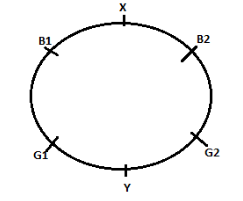
Three boys and three girls are to be seated around a table in a circle. Among them, the boy X does not want any girl neighbor and the girl Y does not want any boy neighbor. How many such arrangements are possible?
(a) 5
(b) 6
(c) 4
(d) 2
Answer
602.1k+ views
Hint- In this question, we will fix the position of boy X in between two boys as mentioned in the question and similarly fix the position of girl Y in between two girls and then calculate the number of ways in which other boys and girls will arrange themselves.
As given in the question, there are three boys and three girls who wanted to sit together in a circle but with some conditions.
Complete step-by-step solution -
Let 3 boys are $B_1, B_2$ and X
And similarly 3 girls are $G_1, G_2 $ and Y

According to the first condition, the boy X does not want any girl neighbor. It means that the boy X does not want to sit adjacent to any girl. So, there is only one way in which boy X can sit which is between two other boys that is $B_1$ and $B_2$. That is, the neighbor of boy X will be the other two boys.
So, the number of ways in which $B_1$ and $B_2$ boys can arrange themselves will be equal to
$
= 2! \\
= 2 \\
$
Similarly, the girl Y does not want to sit adjacent to any boy. So, there is only one way in which girl Y can seat which is between two other girls. That is, the neighbor of girl Y will be the other two girls.
So, the number of ways in which the girls $G_1$ and $G_2$ can arrange themselves will be equal to
$
= 2! \\
= 2 \\
$
$\therefore $ The total number of ways in which all girls and boys will seat together in circle with above mentioned conditions is
$
= 2!*2! \\
= 4 \\
$
Note- For solving these types of questions, we should know the basic permutation concepts. Like in the above question, there are two persons which can sit in two different positions, so the number of ways in which two persons can sit on those seats is $2{P_2}$ which can be solved as 2!
As given in the question, there are three boys and three girls who wanted to sit together in a circle but with some conditions.
Complete step-by-step solution -
Let 3 boys are $B_1, B_2$ and X
And similarly 3 girls are $G_1, G_2 $ and Y

According to the first condition, the boy X does not want any girl neighbor. It means that the boy X does not want to sit adjacent to any girl. So, there is only one way in which boy X can sit which is between two other boys that is $B_1$ and $B_2$. That is, the neighbor of boy X will be the other two boys.
So, the number of ways in which $B_1$ and $B_2$ boys can arrange themselves will be equal to
$
= 2! \\
= 2 \\
$
Similarly, the girl Y does not want to sit adjacent to any boy. So, there is only one way in which girl Y can seat which is between two other girls. That is, the neighbor of girl Y will be the other two girls.
So, the number of ways in which the girls $G_1$ and $G_2$ can arrange themselves will be equal to
$
= 2! \\
= 2 \\
$
$\therefore $ The total number of ways in which all girls and boys will seat together in circle with above mentioned conditions is
$
= 2!*2! \\
= 4 \\
$
Note- For solving these types of questions, we should know the basic permutation concepts. Like in the above question, there are two persons which can sit in two different positions, so the number of ways in which two persons can sit on those seats is $2{P_2}$ which can be solved as 2!
Recently Updated Pages
Why are manures considered better than fertilizers class 11 biology CBSE

Find the coordinates of the midpoint of the line segment class 11 maths CBSE

Distinguish between static friction limiting friction class 11 physics CBSE

The Chairman of the constituent Assembly was A Jawaharlal class 11 social science CBSE

The first National Commission on Labour NCL submitted class 11 social science CBSE

Number of all subshell of n + l 7 is A 4 B 5 C 6 D class 11 chemistry CBSE

Trending doubts
1 Quintal is equal to a 110 kg b 10 kg c 100kg d 1000 class 11 physics CBSE

Why is steel more elastic than rubber class 11 physics CBSE

What is boron A Nonmetal B Metal C Metalloid D All class 11 chemistry CBSE

Bond order ofO2 O2+ O2 and O22 is in order A O2 langle class 11 chemistry CBSE

Discuss the various forms of bacteria class 11 biology CBSE

What is the difference between biodegradable and nonbiodegradable class 11 biology CBSE




